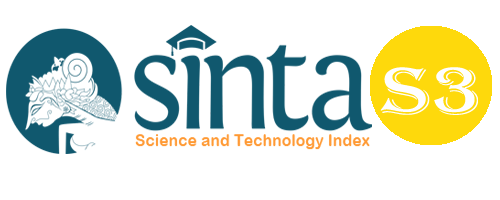Students' Perceptions of the Movie Story of Joy Inspiring Entrepreneurs
Abstract
Movie have an influence in creating audience perceptions and playing attitudes, behaviors, and actions. This study aims to determine student perceptions of the joy film story that inspires entrepreneurship. Qualitative descriptive research approach is used to determine the perception of the film Joy. Selected informants as many as 3 students who can retell the film Joy for students have watched so it is easy to confirm the information. The results of the interview show that Joy's film has a positive perception of the struggle of the entrepreneur character Joy and inspires students to intend to become entrepreneurs.
Keywords
Full Text:
PDFReferences
Astuti, R. et al. (2019). Character Education Values in Animation Movie of Nussa and Rarra. Budapest International Research and Critics Institute-Journal (BIRCI-Journal). P. 215-219
Bolan, P., Boy, S., & Bell, J. (2011). “We’ve seen it in the movies, let’s see if it’s true”: Authenticity and displacement in movie‐induced tourism. Worldwide Hospitality and Tourism Themes.
Dalton, J. T., & Logan, A. J. (2020). Using the movie Joy to teach innovation and entrepreneurship. The Journal of Economic Education, 51(3–4), 287–296.
Freeland, C. (2019). Ethical Engagement with Movies: Response to Carl Plantinga’s Screen Stories. Projections, 13(3), 105–111.
Gosser, H. M. (1996). The Lumière Cinématographe and the Grand Café projection of 1895: A reexamination. SMPTE Journal, 105(10), 653–656.
Josiam, B. M., Spears, D. L., Pookulangara, S., Dutta, K., Kinley, T. R., & Duncan, J. L. (2015). Using structural equation modeling to understand the impact of Bollywood movies on destination image, tourist activity, and purchasing behavior of Indians. Journal of Vacation Marketing, 21(3), 251–261.
Lumière, L. (1936). The Lumiègre Cinematograph. Journal of the Society of Motion Picture Engineers, 27(6), 640–647.
Mardia, M., Hasibuan, A., Simarmata, J., Lifchatullaillah, E., Saragih, L., Purba, D. S., Anggusti, M., Purba, B., Noviastuti, N., & Dewi, I. K. (2021). Kewirausahaan. Yayasan Kita Menulis.
Moleong, L. J. (2007). Metodologi penelitian kualitatif edisi revisi. Bandung: PT Remaja Rosdakarya, 103.
Musyafak, M. A. (2013). Movie Religi sebagai Media Dakwah Islam. Islamic Review: Jurnal Riset Dan Kajian Keislaman, 2(2), 327–338.
Ozaralli, N., & Rivenburgh, N. K. (2016). Entrepreneurial intention: antecedents to entrepreneurial behavior in the USA and Turkey. Journal of Global Entrepreneurship Research, 6(1), 1–32.
Pandey, S. (2012). Using popular movies in teaching cross‐cultural management. European Journal of Training and Development.
Pujiati, J. et al. (2020). Maxims Deviation and Politeness Scale of Uang Panai Mahar Film by Using Leech's Perspective. Budapest International Research and Critics Institute-Journal (BIRCI-Journal). p. 1378-1391
Reijnders, S., Bolderman, L., Van Es, N., & Waysdorf, A. (2015). Locating imagination: an interdisciplinary perspective on literary, movie, and music tourism. Tourism Analysis, 20(3), 333–339.
Sherlywati, S., Handayani, R., & Harianti, A. (2017). Analisis Perbandingan Kemampuan Kewirausahaan Pengusaha Perempuan dan Laki-Laki: Studi pada UMKM di Kota Bandung. Jurnal Manajemen Maranatha, 16(2), 155–166.
Tanskanen, T. (2012). Movie tourism: Study on how movies can be used to promote tourism.
Tofur, S. (2018). Use of Educational Movies in Classroom Management Courses: A Metaphorical Study. Turkish Online Journal of Qualitative Inquiry, 9(4), 389–411.
Vagionis, N., & Loumioti, M. (2011). Movies as a tool of modern tourist marketing. Tourismos, 6(2).
DOI: https://doi.org/10.33258/birci.v4i3.2157
Article Metrics
Abstract view : 122 timesPDF - 118 times
Refbacks
- There are currently no refbacks.

This work is licensed under a Creative Commons Attribution-ShareAlike 4.0 International License.

This work is licensed under a Creative Commons Attribution-ShareAlike 4.0 International License.

_.gif)

















_.gif)



